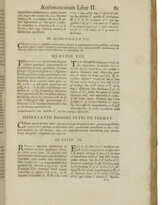ID 1129638
Lot 20 | First printing of Fermat's Last Theorem
Valeur estimée
$ 15 000 – 25 000
First edition of Fermat’s annotated Diophantus, containing his last theorem, the most famous problem in mathematics—from the libraries of two mathematicians of the Scottish Enlightenment. "Fermat was the first European to make extensive contributions to the theory of numbers, taking up the challenge in number theory posed in Diophantus’s Arithmetica. Fermat owned a copy of the Greek editio princeps of Diophantus’s work (1621), edited and annotated by Claude Bachet de Méziriac and published with Xylander’s Latin translation; Fermat often took issue with Bachet’s statements, writing his own results for the most part in the margins of his copy.
Five years after Fermat’s death, his son Claude-Samuel published a second edition of Bachet’s Diophantus, adding to it his father’s marginal notes; these included the famous note stating the still-unproved “theorem” on p. 61 regarding the impossibility of finding a positive integer n > 2 for which the equation xn + yn = zn holds true for the positive integers x, y, and z. Fermat claimed in his note to have discovered a “very wonderful demonstration” (demonstratio sane mirabilis) of this theorem that the margin was too narrow to contain, a claim that has tantalized mathematicians ever since" (Norman). The notorious last theorem went unsolved—but stimulating many developments in mathematics—until 1995, when it was cracked by Andrew Wiles in collaboration with several other mathematicians. A few extant copies contain a portrait or errata leaf, not present here, both of which seem to have been issued somewhat later. Norman 777.
Folio (336 x 228). Engraved vignette on title, engraved head- and tail-pieces and initial (a little toned, a few spots). 19th-century paneled calf. Provenance: Sir John Leslie, 1766-1832, Scottish mathematician and natural philosopher (inscription on pastedown dated 1828) – Edward Sang, 1805-1890, Scottish mathematician and astronomer (inscription on title dated 1833).
| Artiste: | Pierre de Fermat (1607 - 1665) |
|---|
| Artiste: | Pierre de Fermat (1607 - 1665) |
|---|
| Adresse de l'enchère |
CHRISTIE'S 20 Rockefeller Plaza 10020 New York Etats-Unis | ||||||||||||||
|---|---|---|---|---|---|---|---|---|---|---|---|---|---|---|---|
| Aperçu |
| ||||||||||||||
| Téléphone | +1 212 636 2000 | ||||||||||||||
| Fax | +1 212 636 4930 | ||||||||||||||
| Conditions d'utilisation | Conditions d'utilisation | ||||||||||||||
| transport |
Service postal Service de messagerie ramassage par vous-même | ||||||||||||||
| Modes de paiement |
Virement bancaire | ||||||||||||||
| Heures d'ouverture | Heures d'ouverture
|





